Get Magento 2 Related Products Working: Manual Setup & Bulk Import Guide
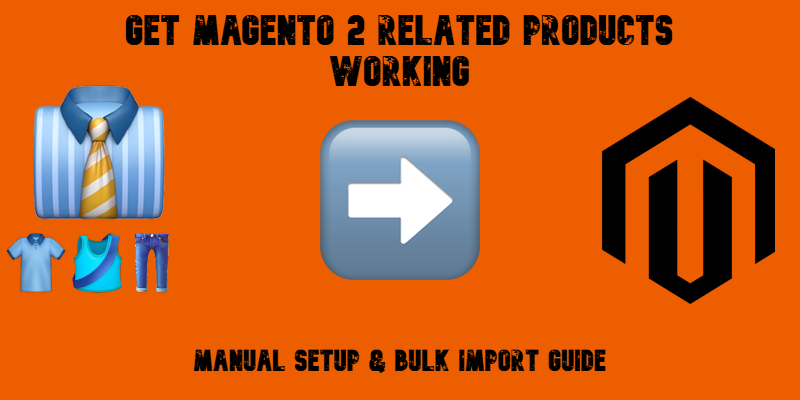
Magento related products are a powerful way to guide your customers toward additional purchases and increase the average order value in your store. By showing relevant items on product pages, you can help shoppers discover complementary or frequently bought-together goods — all while improving the overall shopping experience.
In this guide, we focus entirely on related products in Magento 2 — what they are, why they matter, and how to configure, import, and export them efficiently. Whether you’re setting them up manually or looking for bulk import solutions, we’ve got you covered.
You’ll learn how Magento 2 handles related product relationships, how to structure your import files, and how to avoid common pitfalls during import and export operations. We’ll also show you how to automate related product management using the Improved Import & Export extension — the tool we recommend for scalable Magento product data handling.
Let’s dive into the world of related products Magento 2 store owners can’t afford to overlook.

Table of contents
- What Are Magento Related Products?
- Related Products vs. Cross-Sells vs. Upsells in Magento 2
- How To Configure Related Products In Magento 2 Admin
- Smart Strategies For Assigning Related Products Automatically
- How To Import Related Products In Magento 2
- SEO and Performance Benefits of Using Related Products in Magento 2
- FAQ: Magento 2 Related Products
What Are Magento Related Products?
Magento related products are additional items displayed on a product page to encourage customers to explore more of your catalog. These suggestions are typically complementary to the main product — think of camera accessories shown with a DSLR or socks paired with a pair of sneakers. The goal is to improve user experience, keep customers engaged longer, and boost your average order value (AOV).
In Magento 2, related products appear in a separate block — often labeled “Related Products” — just below the main product description. This Magento related product block is customizable and can be used strategically to promote frequently bought-together items or products that naturally complement each other.
It’s important to distinguish related products from upsells and cross-sells. While upsells suggest more expensive alternatives on the product page, and cross-sells appear at the cart stage (usually promoting impulse buys), related products in Magento 2 serve a middle ground. They’re about relevance, not price or placement. We will return to these three types in the next section.
The benefits of related products in Magento go beyond just sales. They enhance product discoverability, reduce bounce rates, and improve the overall shopping journey by making browsing feel more personalized. By using related products wisely, you can turn a single purchase into multiple, without being pushy.
Related Products vs. Cross-Sells vs. Upsells in Magento 2
As we’ve just mentioned above, Magento 2 offers three types of product relationships — related products, upsells, and cross-sells — that act as built-in marketing tools to boost engagement, drive conversions, and increase the average order value. While all three serve the common goal of increasing purchases, they differ in purpose, placement, and strategy.
Let’s break down the differences and best use cases.
🔗 Magento 2 Related Products — Complementary Items That Go Well Together
Related products in Magento 2 are shown on the same product page and are typically complementary to the item a customer is viewing. They can be chosen manually or assigned based on category, purchase behavior, or shared attributes. For example, if a customer looks at a yoga mat, you might suggest a carrying strap, yoga blocks, or a video course — all within the Magento related product block.
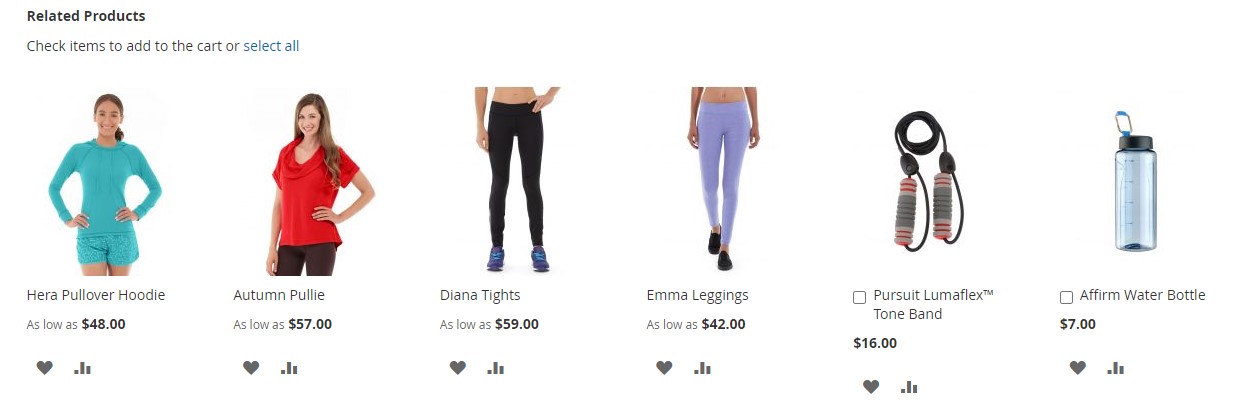
💡 Magento 2 Upsells — Encourage Upgrading To A Better Version
Upsell products are displayed on the product page but aim to steer the shopper toward a more premium version of what they’re considering. Think of it as suggesting an upgrade: a more powerful laptop, a better-known brand, or a product with extra features. Magento 2 upsells are great for increasing order value without changing user intent.
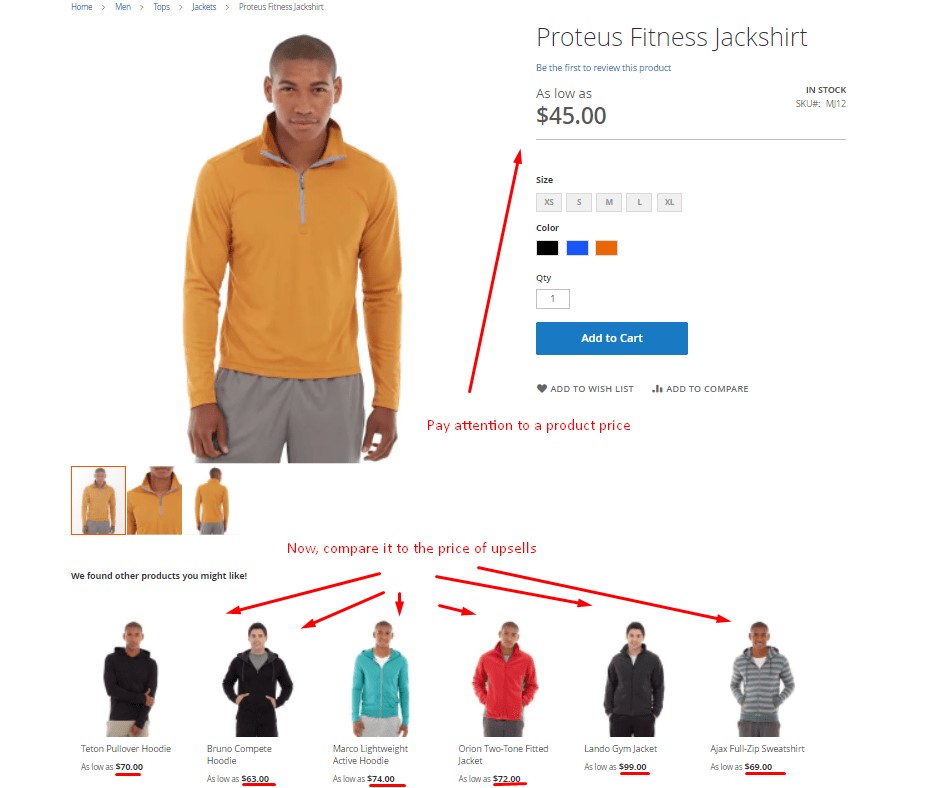
🛒 Magento 2 Cross-Sells — Impulse Buys In The Cart
Cross-sell products appear in the cart, just before checkout — a classic move to capture last-minute attention. These are often small, affordable, and tempting add-ons that align with the main purchase. Examples include batteries, gift wrapping, or limited-time deals.
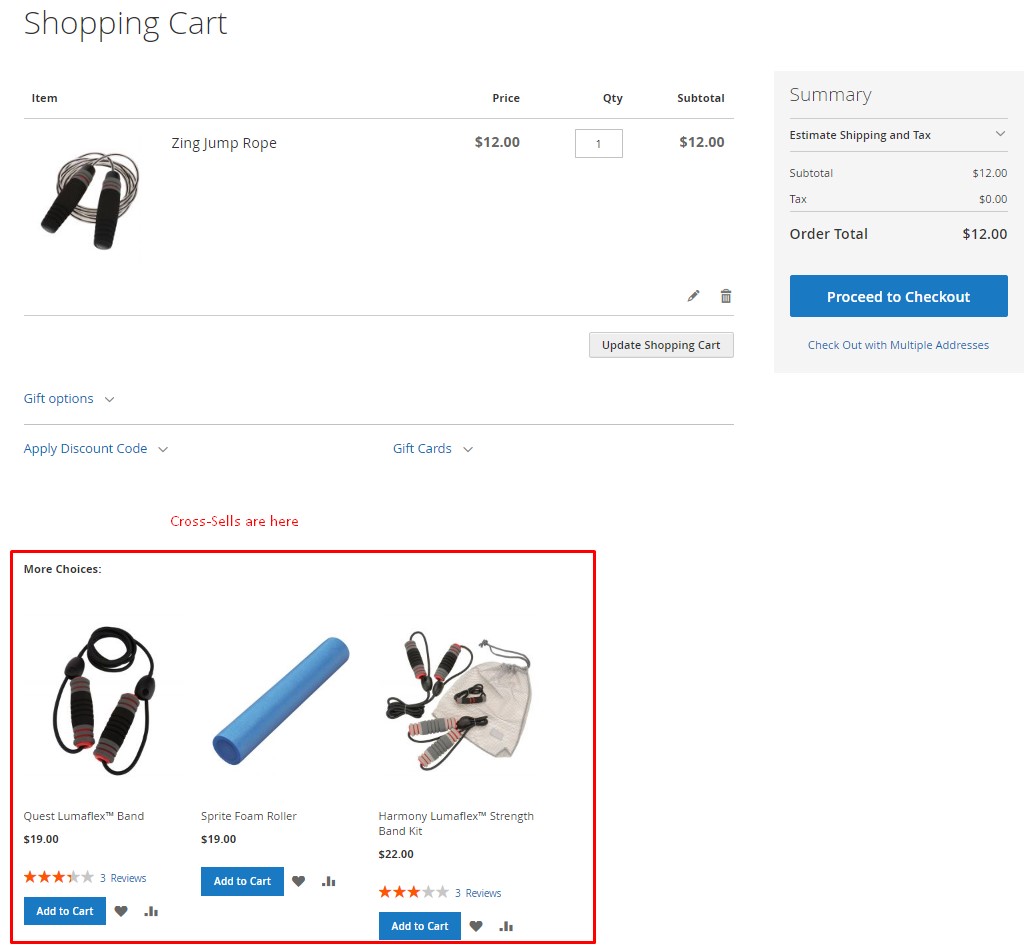
📊 Comparison Table: Magento 2 Related Products, Upsells, and Cross-Sells
| Feature | Related Products | Upsells | Cross-Sells |
| 📍 Display Location | Product page | Product page | Shopping cart |
| 🎯 Main Purpose | Suggest complementary items | Encourage premium upgrades | Trigger impulse buys before checkout |
| 🛠️ Setup Method | Manual or rule-based | Manual | Manual |
| 💰 Price Strategy | Same or lower price | Higher price | Low-cost add-ons |
| 🎁 Example | Yoga mat → yoga block | Basic phone → flagship model | Headphones → cleaning kit |
| 🛒 Buyer Mindset | “What else do I need?” | “Should I upgrade?” | “Why not add this too?” |
By using each of these relations strategically, you can craft a more personalized and profitable shopping journey. While related products in Magento 2 keep users engaged on product pages, upsells drive higher-value purchases, and cross-sells help you squeeze in one last sale before checkout.
How To Configure Related Products In Magento 2 Admin
Manually setting up related products in Magento 2 is straightforward and requires no coding — everything is managed via the Magento backend. While Magento groups related products, up-sells, and cross-sells under one admin section, this part will focus solely on assigning related products.
Follow the steps below to assign related products manually in Magento 2:
- Navigate to Catalog → Products in your Magento 2 admin sidebar to view your product catalog.
- Edit the product you want to add related products to. Find the product you want to enrich with related suggestions and click Edit.
- Scroll down to ‘Related Products, Up-Sells, and Cross-Sells’. On the product edit page, locate the Related Products, Up-Sells, and Cross-Sells section (you may need to expand it).
- Click ‘Add Related Products’. A product grid will appear, allowing you to select one or multiple products to link as related items. Use filters to search by name, SKU, or category.
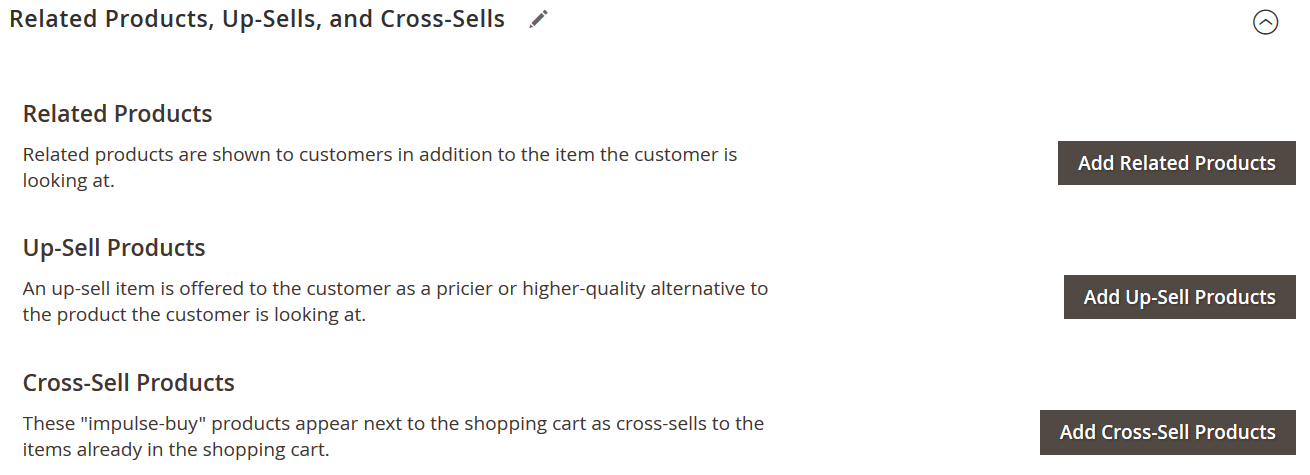
- Select the products and click ‘Add Selected Products’. Once chosen, click Add Selected Products. These items will now appear in the related products Magento 2 block on the frontend.
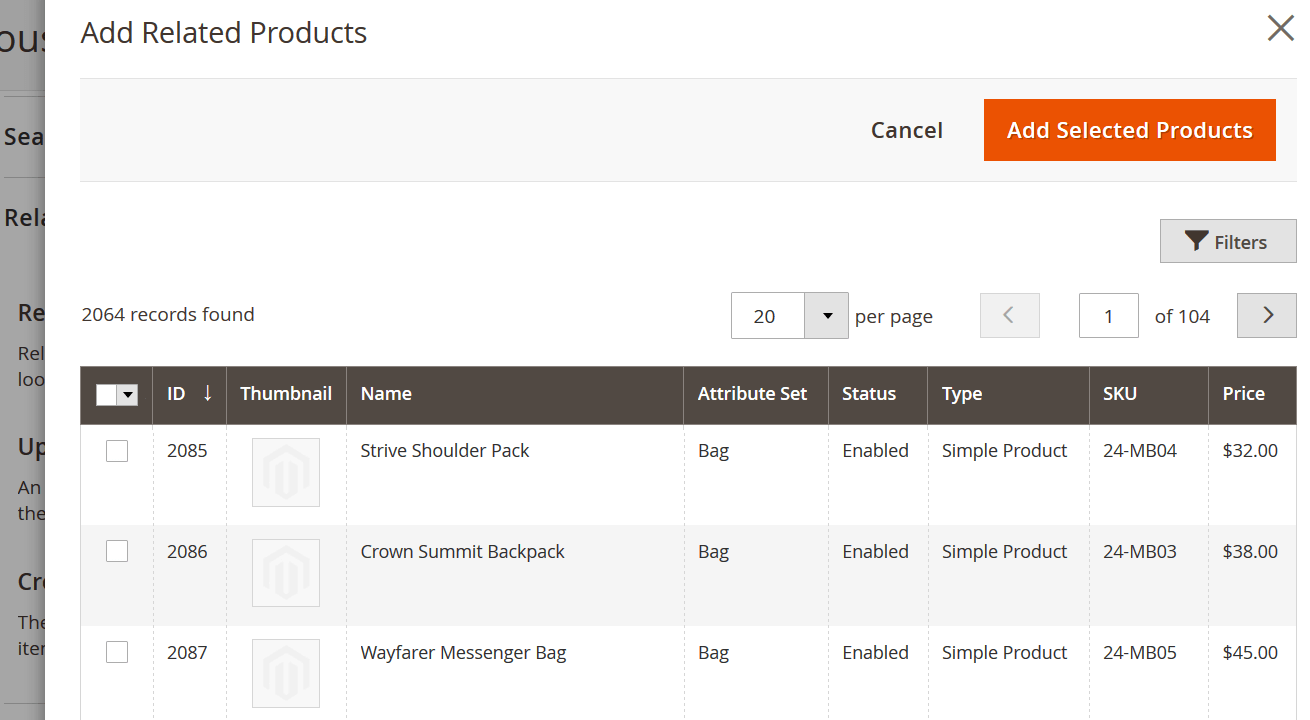
- Save the product. Click Save in the top-right corner to confirm your changes.
💡 Pro Tip: To fine-tune what customers see, organize your related products by category, type, or purchasing behavior (e.g., frequently bought together). This keeps suggestions relevant and increases conversion rates.
By learning how to configure related products in Magento 2, you give your store the tools to guide customer journeys more effectively — all while enhancing the buying experience and increasing your store’s average order value.
Smart Strategies For Assigning Related Products Automatically
Manually assigning related products can be time-consuming, especially for large catalogs. That’s where automation comes in. With Magento 2 related products automation, you can scale your product relationships and create a more personalized shopping experience using rules, conditions, and even AI.
Magento 2 allows you to auto-generate related products based on product attributes, cart conditions, customer behavior, and more. This rule-based system helps you maintain relevant recommendations without needing to assign products one by one.
🔄 How To Get Related Products In Magento 2 Using Automation
Using Product Related Rules, Magento store owners can create dynamic product relationships based on custom logic. Here’s how it works:
- Go to Marketing > Product Related Rules in the Magento Admin.
- Click Add Rule to create a new automation.
- Define the rule name, enable the rule, and choose a priority if multiple rules are applied.
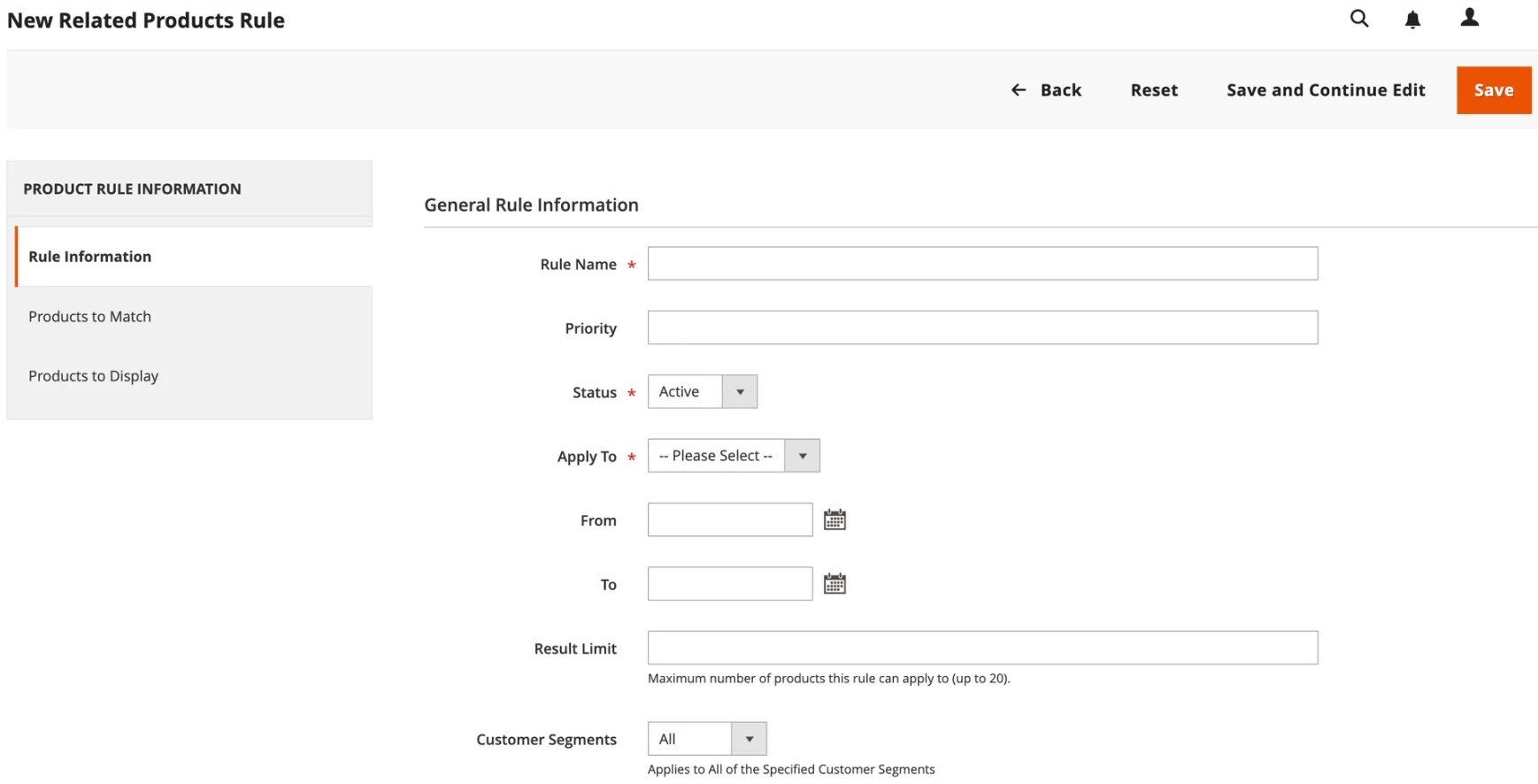
- You can set Apply To to one of the following: Related Products, Up-sells, or Cross-sells. Choose Related Products.
- Set Conditions. In Products to Match, define when the rule applies.
- Under Actions (Products to Display), choose what products should be shown — for example, products from the same category or those with a shared attribute.
- Click Save.
Rules are evaluated in real time, which means shoppers will always see the most relevant products based on your logic.
📌 Learn more in Adobe’s official guide:
🤖 Advanced Automation Ideas
- Frequently Bought Together Logic – Link products based on customer order data.
- Same Attribute Value – Assign products with shared characteristics (e.g., color, brand).
- AI Extensions – Consider third-party solutions that use machine learning to generate highly personalized related product blocks.
With the right strategy, you can get related products in Magento 2 to work for you automatically, saving time while delivering more relevant offers and boosting your average order value. However, it is not the only way to simplify your related products management in Magento 2. You can also import them.
How To Import Related Products In Magento 2
If you’re managing a large catalog, assigning product relationships manually is not scalable. Fortunately, Magento 2 lets you import related products in bulk, saving hours of manual effort. Whether you’re managing thousands of SKUs or frequently updating product associations, using a structured CSV file and a powerful tool like Firebear’s Improved Import & Export extension allows you to automate and streamline the process.
📥 Magento 2 Related Product Import Sample CSV: What You Need
To import related products in Magento 2, you’ll need a properly formatted CSV file. Here’s what it should include:
- related_skus — Add the SKUs of related products here, separated by commas
- upsell_skus — Optional, for upsell items
- crosssell_skus — Optional, for cross-sell items
Each of these fields should contain SKUs (not product names), like so:
related_skus
SKU123,SKU456,SKU789

💡 Pro Tip: Use Google Sheets to edit your CSVs for clarity and version control. You can even import directly from Google Sheets using our extension.
👉 See our Google Sheets Import Guide
👉 Get a sample Magento 2 related products import sheet
👉
⚙️ Native Magento 2 Import Method
Magento doesn’t have a separate entity for related products. Instead, product relations are imported as part of the Products entity.
To use the default import tool:
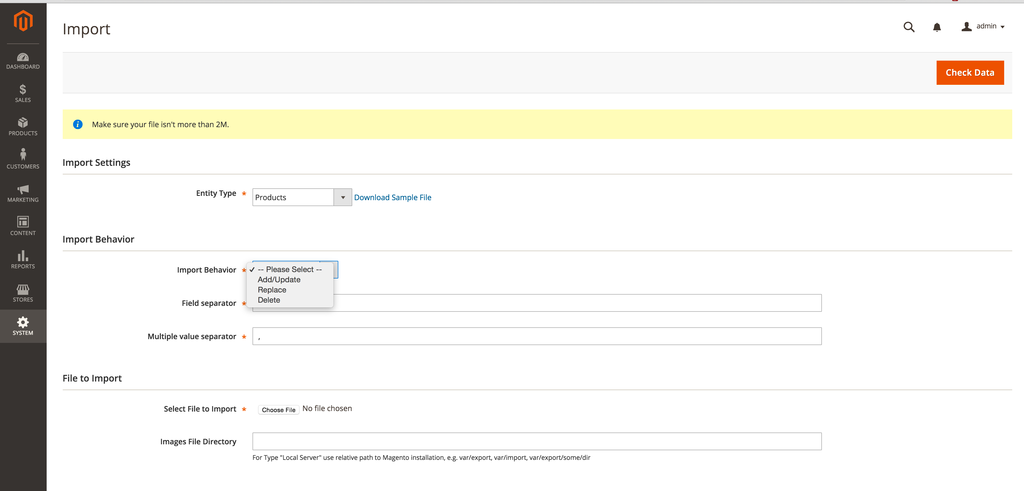
- Go to System > Data Transfer > Import
- Set Entity Type to Products
- Select Add/Update as the import behavior
- Upload your CSV file with the related_skus column
- Configure delimiters if needed
- Click Check Data and proceed with the import
This native method is simple but limited — it supports only basic formats and manual uploads.
🚀 Automate Related Product Imports in Magento 2 with Improved Import & Export
To scale your workflow, we recommend the Improved Import & Export extension. It supports:
- Multiple formats: CSV, XML, JSON, XLSX, ODS
- Multiple sources: FTP, SFTP, Dropbox, direct URLs, REST/SOAP APIs, Google Sheets
- Cron scheduling for fully automated imports
- Flexible mapping and advanced attribute handling
🔄 Steps to import Magento 2 related products with Firebear:
- Go to System > Improved Import & Export > Import Jobs
- Click Add New Job and enable it
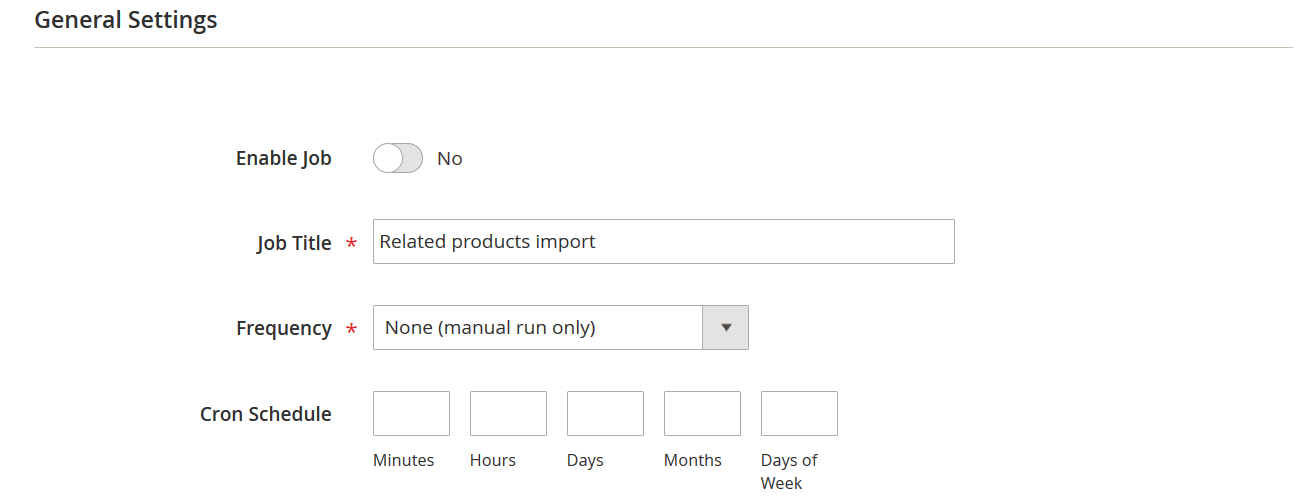
- Set the job name and choose whether it runs manually or on a schedule
- Choose Products as the entity type
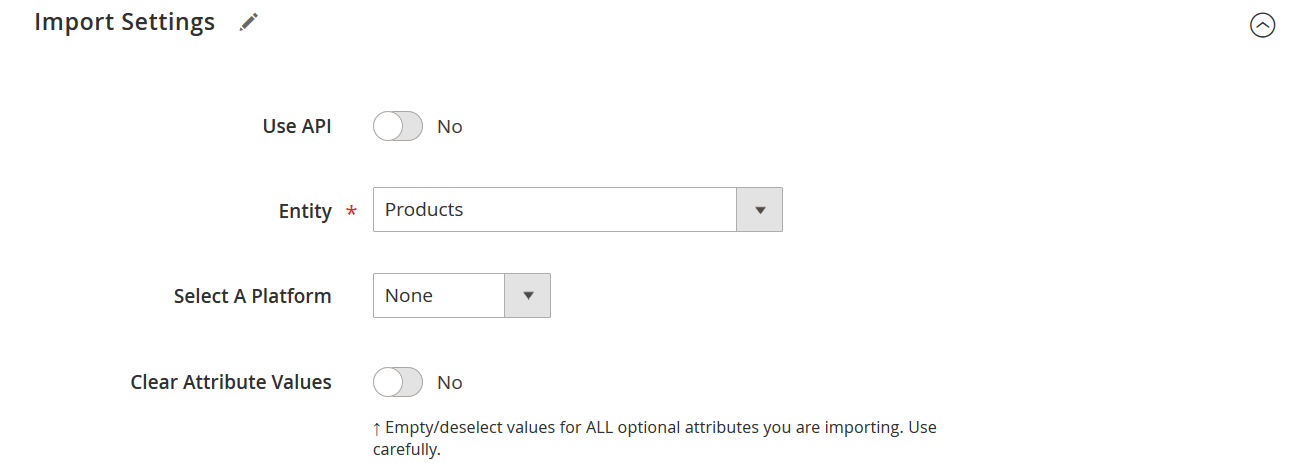
- Adjust import behavior and configure separators

- Set up your import file format (e.g., CSV) and source (e.g., Google Sheets or FTP)

- Upload your file with related_skus
- Use mapping to adapt third-party data formats
- Save and run the job
- Reindex and clear the cache if necessary
📌 Bonus: You can also configure post-import actions like image path mapping, attribute updates, or URL rewrites — ideal for syncing data across multiple systems.
By using the right tool and format, you can automate related product imports in Magento with precision and speed. This not only improves efficiency but also ensures customers always see relevant product suggestions, driving engagement and higher order values.
Common Errors When Importing Related Products And How To Fix Them
Running into issues with your Magento related product import? You’re not alone. Even experienced store owners occasionally find their Magento import related products not working due to small but critical errors in their import files or job configurations.
Let’s walk through the common issues with Magento 2 related product import and how to troubleshoot them effectively.
⚠️ 1. Missing or incorrect SKUs
Problem: The SKUs listed in the related_skus column don’t exist in your catalog, or they’re misspelled.
Fix:
- Double-check all SKUs in your import file.
- Use data validation tools like Google Sheets’ data validation or conditional formatting to spot errors.
- Run a quick export of your product catalog and cross-reference SKUs.
⚠️ 2. Wrong column formatting
Problem: SKUs are not separated properly — e.g., using semicolons or spaces instead of commas.
Fix:
- Ensure SKUs are comma-separated in the related_skus field.
- Use plain text formatting, not formulas or styled cells.
✅ Correct format:
related_skus
SKU123,SKU456,SKU789
⚠️ 3. Using unsupported file types or encodings
Problem: You’re uploading an Excel file or a CSV with incompatible encoding.
Fix:
- Always save your file as UTF-8 encoded CSV.
- Use Google Sheets or LibreOffice Calc for safe formatting.
⚠️ 4. Import behavior conflicts
Problem: The import job is set to “Replace” instead of “Add/Update,” wiping existing product data.
Fix:
- Use Add/Update as the import behavior when importing related products.
- This ensures existing product data remains intact while new relations are added.
⚠️ 5. Entity type mismatch
Problem: Trying to import related products as a separate entity.
Fix:
- Magento does not support a dedicated “related products” entity.
- Always import related items as part of the Products entity.
⚠️ 6. Validation errors and silent failures
Problem: The import runs but doesn’t assign related products, and no clear error is shown.
Fix:
- Use the Check Data function before finalizing the import.
- Review Magento logs for detailed error reports.
- If using the Improved Import & Export extension, check the job logs for skipped rows or invalid attributes.
By understanding how to fix Magento related product import errors, you’ll save time, reduce rework, and ensure your product relationships display correctly. A clean, validated import file and proper configuration are key to a smooth experience, especially when dealing with thousands of SKUs.
Next up, let’s explore how to export related product data from Magento 2.
How To Export Related Products in Magento 2
If you want to back up, audit, or migrate product relationships, you’ll need to export related products in Magento 2. Unfortunately, Magento’s native export tool doesn’t support exporting product relations like related products, upsells, or cross-sells. That’s where Firebear’s Improved Import & Export extension becomes essential.
This powerful tool allows you to extract the related product data structure in Magento along with all associated product information, giving you full control over your catalog relationships.
📤 Use Cases For Exporting Related Products
Exporting related product data can help with:
- 🔍 Auditing product relations across large catalogs
- 🔁 Re-importing into staging or live environments
- 🔄 Syncing data between multiple Magento instances
- 📊 Analyzing product recommendations and upsell performance
🛠 Magento 2 Export Product Relations with Improved Import & Export
Here’s how to export related products from Magento 2 step by step:
- Go to System > Improved Import & Export > Export Jobs
- Click Add New Job and configure general settings:
- Name the job
- Enable Consecutive Export to only export products modified since the last run
- Choose a trigger event (e.g., cron-based, order placed, product updated) if applicable or create a cron schedule.
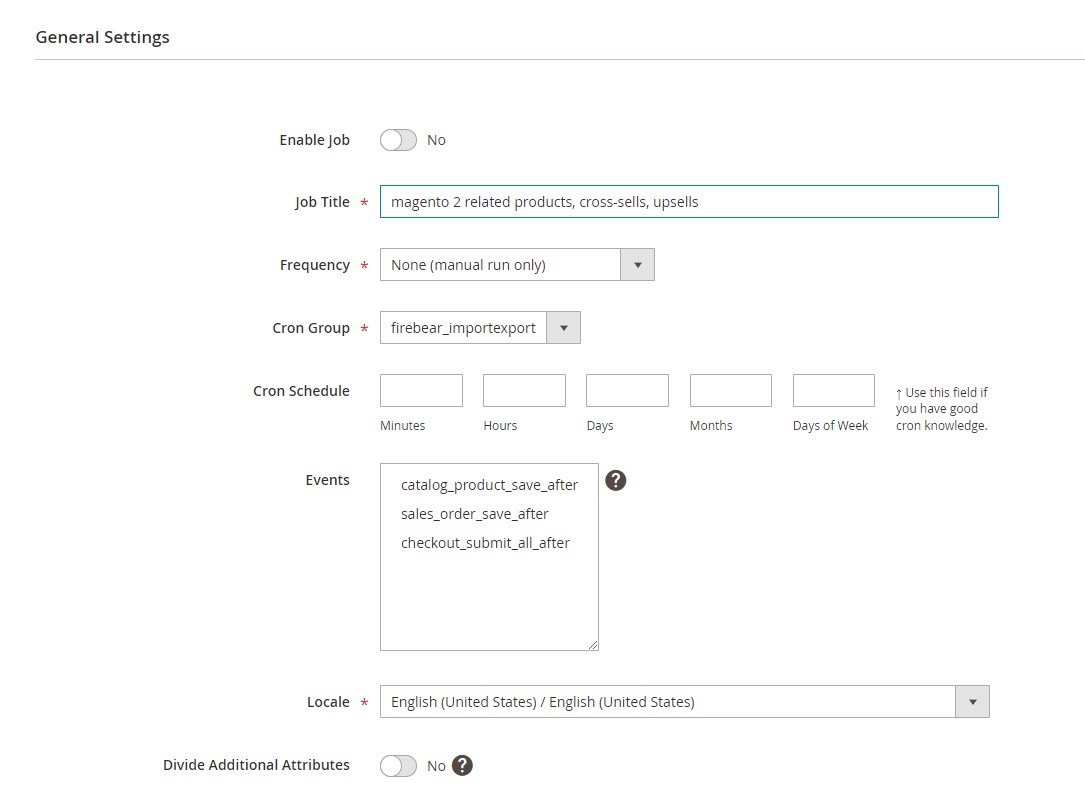
- Under Export Settings:
- Set Entity Type to Products (this includes related_skus, upsell_skus, and crosssell_skus columns)
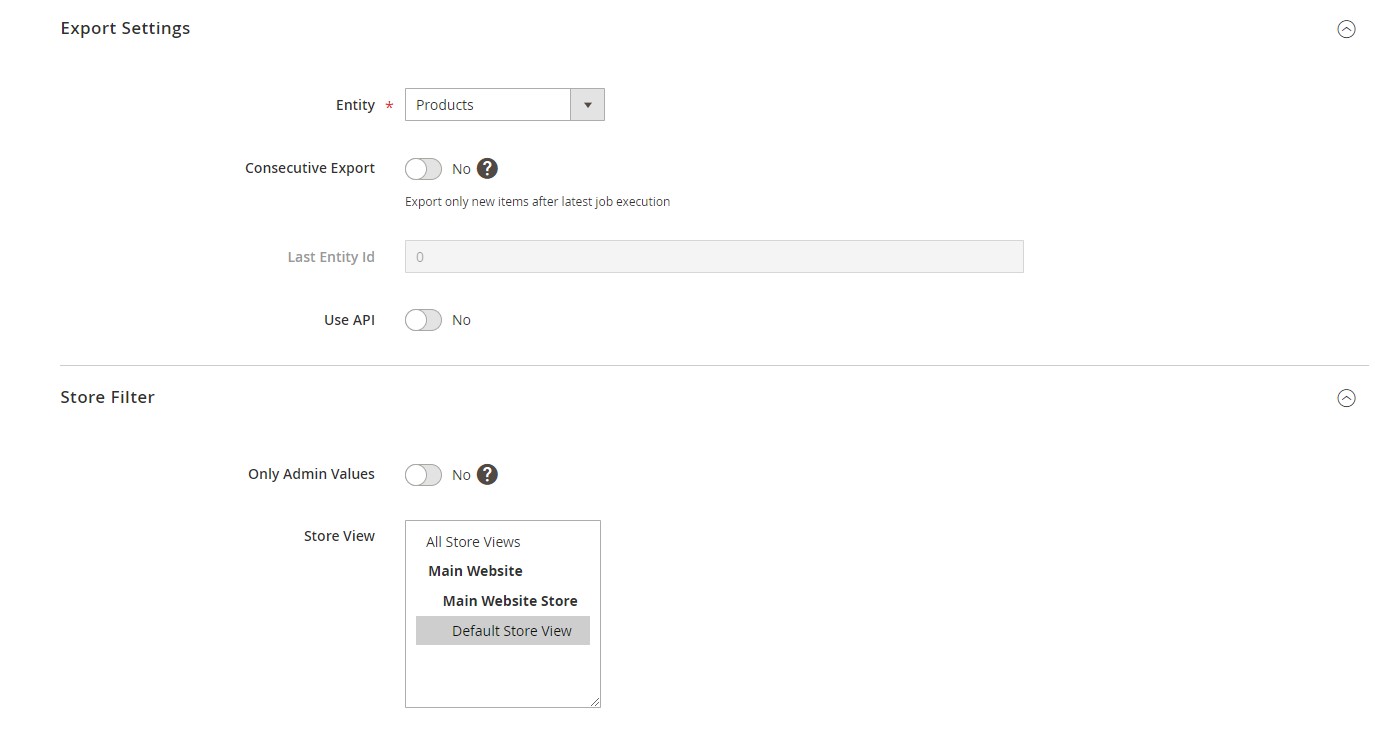
- Define the export source (local folder, remote FTP, Dropbox, Google Sheets, etc.)
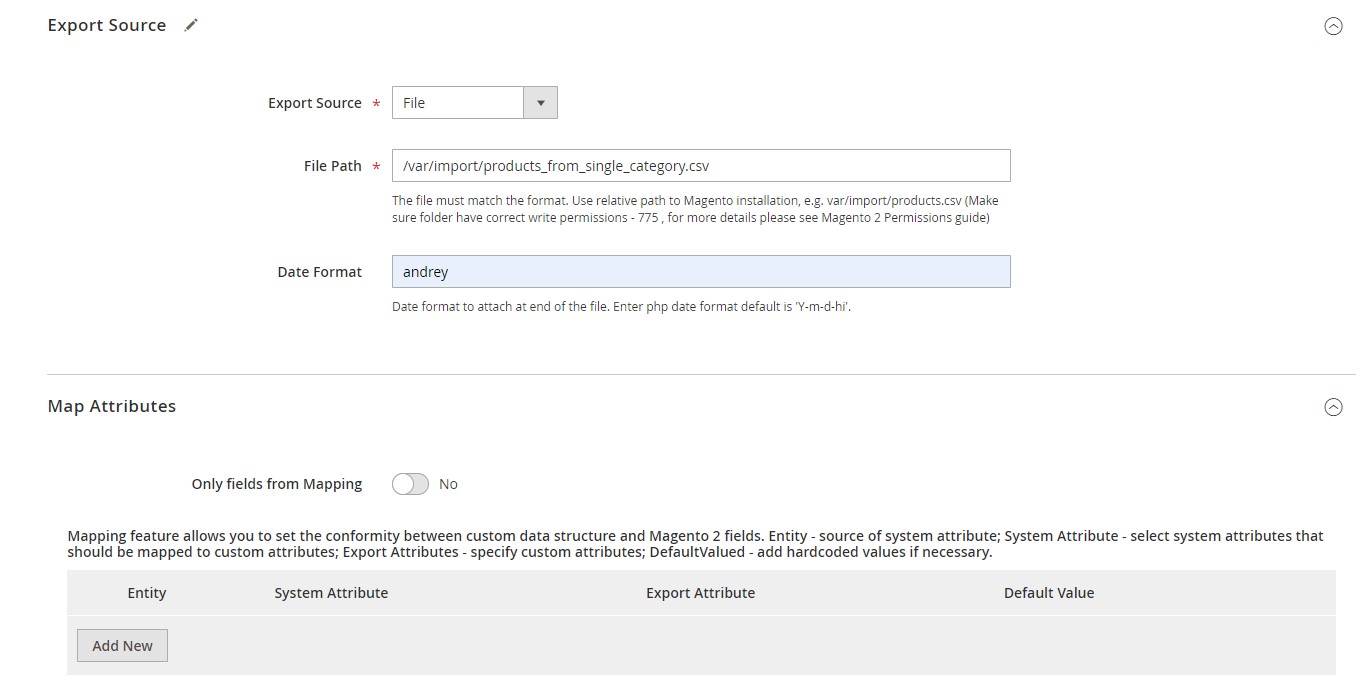
- Choose the file format: CSV, XML, JSON, XLSX, or ODS
- Set Entity Type to Products (this includes related_skus, upsell_skus, and crosssell_skus columns)
- Optional:
- Use attribute filters to narrow down what gets exported (e.g., by category or product type)

- Enable attribute mapping to match export structure with external platforms
- Use attribute filters to narrow down what gets exported (e.g., by category or product type)
- Save and run the export job
✅ After exporting, you’ll get a structured file like this:
sku, name, related_skus
SKU001, Yoga Mat, SKU002,SKU003
This format mirrors the Magento 2 related product import sample CSV, so the exported file can be used directly for re-import or external processing.
🔗 Connect Magento to Any System via API or File
The Improved Import & Export extension supports exporting related product data via REST and SOAP APIs. This is especially useful for:
- ERP integrations
- Third-party PIM tools
- Multi-store Magento setups
- External analytics dashboards
By using this method to export product relations from Magento 2, you gain full control over your catalog’s promotional structure. Whether for audit, migration, or integration, exporting related products with the right tool ensures data consistency and business agility.
SEO and Performance Benefits of Using Related Products in Magento 2
Adding related product blocks to your Magento 2 store isn’t just good for conversions — it’s also a smart move for your SEO and overall store performance. When used strategically, Magento related products can impact several key areas:
🔗 1. Improved internal linking structure
Each time you assign related products to a product page, you’re creating additional internal links between products. This benefits SEO by:
- Helping search engines better crawl and index your site
- Spreading link equity across your product catalog
- Building a contextual relationship between products
Search engines love clear site architecture, and related products in Magento 2 make that structure deeper and more connected.
⏱ 2. Increased time on page and reduced bounce rates
When customers encounter related products Magento 2 blocks, they’re more likely to click through to other items, even if the original product doesn’t meet their needs. This leads to:
- Longer session durations
- Lower bounce rates
- More pages per visit
In SEO terms, these behavioral signals are often viewed as indicators of content quality and relevance.
💸 3. Higher conversion rates and average order value
Magento 2 related products help shoppers discover what they didn’t know they needed. By showcasing complementary items (e.g., a phone case next to a smartphone), you’re subtly encouraging multi-item purchases, which directly boosts:
- Conversion rates
- Average order value (AOV)
- Cross-category product visibility
🧠 4. Smarter customer journey mapping
When you automate related product assignment using categories or behavior (as shown earlier), you can align product discovery with actual user intent, leading to a more intuitive shopping experience and higher satisfaction.
Final Words: Make Magento 2 Related Products Work for You
When managed properly, Magento 2 related products can do more than just fill space on your product pages — they can actively drive conversions, boost average order value, and improve your store’s SEO performance. A thoughtfully placed related product block not only helps shoppers discover more but also guides them toward more informed purchases.
However, as your catalog grows, manually assigning related products becomes time-consuming and prone to error. That’s where automation steps in — and our Improved Import & Export extension is built to handle the challenge. Whether you’re managing 50 products or 50,000, the extension helps you import, export, and automate product relationships effortlessly.
With support for CSV, XML, JSON, Google Sheets, and REST/SOAP APIs, this tool goes far beyond native Magento functionality and includes powerful features like cron scheduling, attribute mapping, and validation logs.
📥 Ready to supercharge your product relations?
- 👉 Download the Improved Import & Export extension
- 📚 Need help? Check out the user manual
- 💬 Still have questions? Contact the Firebear support team
Let Magento 2 related products become a growth engine for your store — not just a feature you use, but one you master.
Want to master Magento 2 import from A to Z? Explore our complete guide and unlock step-by-step tutorials, tips, and expert tools.
👉 Go to the Full Magento 2 Import & Export Guide
FAQ: Magento 2 Related Products
How to get related products programmatically in Magento 2?
You can retrieve related products programmatically in Magento 2 using the getRelatedProducts() method from the product model. Simply load the product by SKU or ID and call this method to return an array of related product objects.
Can I import related products in Magento 2 without affecting existing product data?
Yes. When using the Improved Import & Export extension, select the Add/Update import behavior. This ensures your related product data is added or updated without overwriting other product attributes such as descriptions or prices.
What’s the difference between related products and custom product links in Magento?
Magento 2 related products are predefined suggestions shown on product pages to increase engagement. Custom product links, on the other hand, allow developers to define custom relationships (e.g., accessories, bundles) programmatically for more advanced use cases.
How do I configure related products in the Magento 2 admin panel?
Navigate to Catalog > Products, select a product, and scroll down to the Related Products, Up-Sells, and Cross-Sells section. Click Add Related Products, choose the relevant items from the list, and save the product.
What is the Magento related product block and where does it appear?
The Magento related product block is a section on the product detail page that displays items marked as related. Its placement depends on your theme layout, but it typically appears below the product description or in the sidebar.
Can I export related products from Magento 2 for audit or migration?
Yes. You can use the Improved Import & Export extension to export related products in Magento 2 alongside product data. This is useful for catalog audits, backups, and transferring product relationships between Magento instances.
How do I fix Magento import related products not working correctly?
Start by checking that all SKUs in the related_skus column exist in your product catalog. Use comma-separated formatting, ensure the file is UTF-8 encoded, and set the import behavior to Add/Update. Also, review Magento logs and job validation output for errors.
What is the best way to automate related product imports in Magento 2?
The best way is by using Firebear’s Improved Import & Export extension. You can automate imports via cron jobs, pulling data from sources like Google Sheets, FTP, APIs, or cloud storage. Mapping tools and presets make the process seamless.
Is there a sample CSV for Magento 2 related product import?
Yes. Firebear provides a that includes fields like sku, name, and related_skus. Use this format to structure your import files accurately.
What are the common issues with Magento 2 related product import and how can I avoid them?
Common issues include missing or incorrect SKUs, wrong delimiters, invalid encoding, and incorrect import behavior settings. To avoid them, always validate your CSV file, use UTF-8 encoding, test on a staging environment, and check logs after import.

